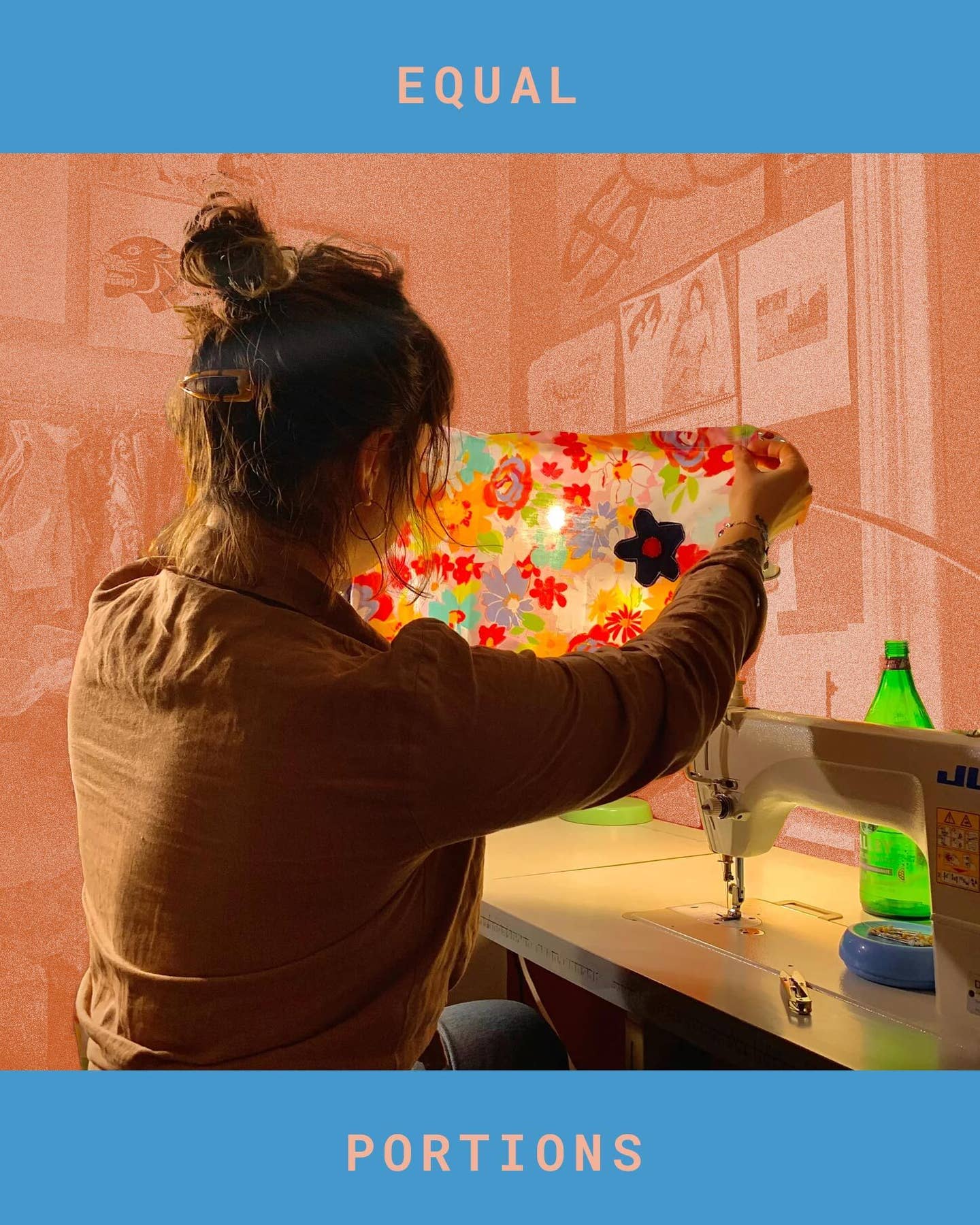How to Save the Planet, One Apron at a Time
Meet the designer giving old clothes a second life in the kitchen.

Food is more than what’s on the plate. This is Equal Portions, a series by editor-at-large Shane Mitchell, investigating bigger issues and activism in the food world, and how a few good eggs are working to make it better for everyone.
“I save all my scraps,” says textile artist Chantal Galipeau. “Collect them at yard sales, thrift shops, and get tons of donations from people’s closets.” In 2015, Galipeau received a fine arts degree from the Pratt Institute, where she minored in sustainability practices. At the time, she wasn’t sure how that would translate into a career, but Galipeau did know she liked to mend things. “As a broke college student, I couldn’t afford nice fabric, but then fashion upcycling started to take off, and as we all know, there’s so much textile waste in the world.”
She took the scraps and deadstock she collected, and by stitching whimsical motifs onto vintage garments or thrift store finds, turned them into one-of-a-kind pieces. When she posted them on Instagram, Galipeau’s reimagined clothes, from a sweatshirt emblazoned with the word “Oysters” to a button-down adorned with wine glasses, quickly sold out, and custom commissions poured in. On her website, she states: “The process may include patching holes, covering stains or hiding the team logo on the front of a crewneck. The hope is to inspire us to care more for our clothing, while offering a solution for the pieces we no longer love. It's up to us to take care of each other, and the spaces we inhabit.” Word then spread from loyal customers to some chefs in Providence, Rhode Island, where she now lives, and that’s how Galipeau met Pickerel owner Scott LaChapelle, who didn’t want to toss out a tattered but treasured pair of Japanese selvedge denim jeans.
A new kitchen apron was born.
We already know about food waste solutions—both fine dining restaurants and fast food chains have hyped virtuous policies to cut down on trash, including biofuel reuse, composting, soup kitchen donations, and sharing scraps with livestock farmers. Some conscientious snack food companies seek certification for qualifying products from the Upcycled Food Association. Chef Dan Barber of Blue Hill at Stone Barns has been a particularly vocal advocate of “rescued” ingredients and zero-waste kitchens. He has even doubled down by collaborating with ceramic artist Gregg Moore, who upcycled the femurs of grass-fed cattle raised specifically for Blue Hill, transforming shards into phenomenal bone china serving pieces. Moore also ground up broken and chipped china from Barber’s dining room and created new dinner plates, an elegant expression of circular economy theory driving regenerative culinary projects. But what about the food world’s other waste streams?
Namely, where do all those stained bar towels go to die?
The amount of clothing and other non-durable goods dumped in landfills was last estimated by the Environmental Protection Agency to be about 17 million tons annually. Worn out staff uniforms, table linens, aprons, wipes, mop heads, drainage and safety floor mats are part of that trash pile. But it doesn’t all have to wind up there. Surprisingly, McDonald’s and Subway have been early adopters in the U.K., commissioning “closed-loop” uniforms made with recycled fibers and plastics. (Closed-loop systems use discarded materials that wind up in new products, keeping textiles in circulation for as long as possible.) Cintas, one of the largest workwear apparel manufacturers supplying the restaurant sector, has partnered with Leigh Fibers, a textile waste and reprocessing company, to create a recycling program for out-of-service gear here in the States.
Then, there are micro-initiatives like those by Galipeau and LaChapelle.
“There is such a high standard for sanitizing things in restaurants, that’s why so many are pressured to have a linen service,” says LaChapelle. “But we’re so small, and don’t have an apron service. We tend to our own, and make sure they’re clean. Another chef has an apron from Chantal, too. We’re trying to cut down on the waste that way.” Major restaurant groups typically resort to professional rental services that collect dirty linens and deliver freshly laundered ones in their place. It’s a costly aspect of doing business for young restaurateurs starting out, and the white-tablecloth aesthetic may not match their dining concept. LaChapelle began his career working in a pizza shop, where his boss insisted on leasing cheap polyester-nylon aprons. He hated them. When LaChapelle opened Pickerel, his 21-seat noodle bar in Providence’s Luongo Square, he finally got to wear whatever he wanted.
“I had these old jeans and wanted to do something with them,” he says. “A pair of Samurai that I bought on a trip to Osaka. I spent so much time breaking them in from brand new, when they were so stiff they could stand up on their own. It seemed a shame to just toss something like that.”
He commissioned Galipeau to give them another life.
“Every piece of mine is one of a kind,” she explains. “Or produced in small quantities. I asked him, ‘What do you need in your daily life, and what could we do to repurpose this, so you don’t have to part with those beautiful jeans?’”
Galipeau re-cut the fabric, mended and patched holes, added pockets for LaChapelle’s essential tools, which include a Sharpie and a tasting spoon, and backed the reclaimed denim with deadstock canvas. “He wears it all the time,” she says.
“For a second project, Chantal just made me a knife roll,” says LaChapelle.
If you need a pair of tattered denim reimagined for your kitchen, Galipeau might be your gal.
Please consider using a recycling service like Retold to dispose of your own worn out kitchen textiles.
Keep Reading
Continue to Next Story










